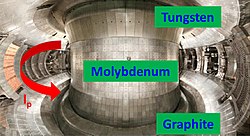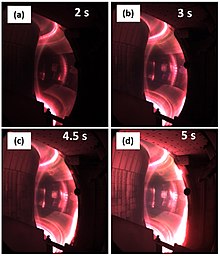

| Experimental Advanced Superconducting Tokamak | |
|---|---|

EAST vacuum vessel
| |
| Device type | Tokamak |
| Location | Hefei, China |
| Affiliation | Hefei Institutes of Physical Science, Chinese Academy of Sciences |
| Technical specifications | |
| Major radius | 1.85 m (6 ft 1 in) |
| Minor radius | 0.45 m (1 ft 6 in) |
| Magnetic field | 3.5 T (35,000 G) |
| Heating power | 7.5 MW |
| Discharge duration | 102 s |
| Plasma current | 1.0 MA |
| Plasma temperature | 100×106 K |
| History | |
| Year(s) of operation | 2006–present |
| Preceded by | HT-6M |
| Experimental Advanced Superconducting Tokamak | |||||||
|---|---|---|---|---|---|---|---|
| Chinese | 先进超导托卡马克实验装置 | ||||||
| Hanyu Pinyin | xiānjìn chāodǎo tuōkǎmǎkè shíyàn zhuāngzhì | ||||||
| Literal meaning | Advanced Superconducting Tokamak Experimental device | ||||||
| |||||||


The Experimental Advanced Superconducting Tokamak (EAST), internal designation HT-7U (Hefei Tokamak 7 Upgrade), is an experimental superconducting tokamak magnetic fusion energy reactor in Hefei, China. The Hefei Institutes of Physical Science is conducting the experiment for the Chinese Academy of Sciences. It has operated since 2006.
It is the first tokamak to employ superconducting toroidal and poloidal magnets. It aims for plasma pulses of up to 1,000 seconds.
Since China is a member of the international ITER project, it is hoped that EAST will provide new impetus for its further development.
EAST followed China's first superconducting tokamak device, dubbed HT-7, built by the Institute of Plasma Physics in partnership with Russia in the early 1990s.[citation needed]
The project was proposed in 1996 and approved in 1998. According to a 2003 schedule,[1] buildings and site facilities were to be constructed by 2003. Tokamak assembly was to take place from 2003 through 2005.
Construction was completed in March 2006 and on September 28, 2006, "first plasma" was achieved.[2]
According to official reports, the project's budget is CNY ¥300 million (approximately US$37 million), some 1/15 to 1/20 the cost of a comparable reactor built in other countries.[3]
On September 28, 2006, first plasma was achieved—the first test lasted nearly three seconds, and generated an electric current of 200 kiloamperes.[2]
By Jan 2007 "the reactor created a plasma lasting nearly five seconds and generating an electric current of 500 kilo amperes".[4]
On November 7, 2010, EAST achieved its first H-mode plasma by LHW alone.[citation needed]
In May 2011, EAST became the first tokamak to successfully sustain H-Mode plasma for over 30 seconds at ~50 million Kelvin.
On November 29, 2011, The ribbon-cutting ceremony for EAST auxiliary heating system project was held, signifying EAST's entering of “Phase-II”.
On May 19, 2014, after nearly 20-month-long upgrading break since September 2012, EAST was ready for the first round of experiments in 2014.
By May 2015, EAST was reporting 1 MA currents, and H-mode for 6.4 seconds.[5]
In February, 2016, a plasma pulse was maintained for a record 102 seconds at ~50 million °C.[6] Plasma current of 400kA and a density of about 2.4 x 1019/m3 with slowly increasing temperature.[6]
On November 2, 2016, EAST became the first tokamak to successfully sustain H-Mode plasma for over a minute at ~50 million °C.[7]
On July 3, 2017, EAST became the first tokamak to successfully sustain H-Mode plasma for over 100 seconds at ~50 million °C.[8]
On November 12, 2018, EAST reached a milestone of 100 million °C electron temperature.[9]
In May, 2021, EAST reached a milestone of 120 million °C electron temperature for 101 seconds.[10]
On December 30, 2021, a long-pulse high-parameter plasma operation of 1056 seconds was realized, which once again created a new world record for the operation of the Tokamak experimental device.[11][12]
On April 12, 2023, EAST achieved the world's first 403-second steady-state H-mode plasma.[13]
China is a member of the ITER consortium, and EAST is a testbed for ITER technologies.[14]
EAST was designed to test:
| Toroidal field, Bt | 3.5 T |
| Plasma current, IP | 1.0 MA |
| Major radius, R0 | 1.85 m |
| Minor radius, a | 0.45 m |
| Aspect ratio, R/a | 4.11 |
| Elongation, κ | 1.6–2 |
| Triangularity, δ | 0.6–0.8 |
| Ion cyclotron resonance heating (ICRH) | 3 MW |
| Lower hybrid current drive (LHCD) | 4 MW |
| Electron cyclotron resonance heating (ECRH) | None currently (0.5 MW planned) |
| Neutral beam injection (NBI) | None currently (planned) |
| Pulse length | 1–1000 s |
| Configuration | Double-null divertor Pump limiter Single null divertor |
|
| |||||||||||
|---|---|---|---|---|---|---|---|---|---|---|---|
| Operating power plants |
| ||||||||||
| Power plants under construction |
| ||||||||||
| Planned power plants |
| ||||||||||
| Proposed power plants |
| ||||||||||
| Research, experimental and prototype reactors |
| ||||||||||
| Commercial reactor designs |
| ||||||||||
| Organizations |
| ||||||||||
| Related categories |
| ||||||||||
| |||||||||||
|
Fusion power, processes and devices
| |||||||||||||||||||||||||||||||||||||||||||||||||
|---|---|---|---|---|---|---|---|---|---|---|---|---|---|---|---|---|---|---|---|---|---|---|---|---|---|---|---|---|---|---|---|---|---|---|---|---|---|---|---|---|---|---|---|---|---|---|---|---|---|
| Core topics |
| ||||||||||||||||||||||||||||||||||||||||||||||||
| Processes, methods |
| ||||||||||||||||||||||||||||||||||||||||||||||||
| Devices, experiments |
| ||||||||||||||||||||||||||||||||||||||||||||||||
31°54′42″N 117°08′49″E / 31.91174°N 117.14682°E / 31.91174; 117.14682